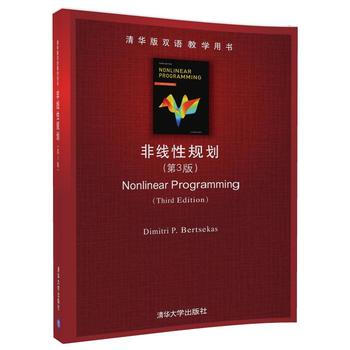

具體描述
| 圖書基本信息 | |
| 圖書名稱 | 非綫性規劃(第3版) |
| 作者 | Dimitri P. Bertsekas |
| 定價 | 169.00元 |
| 齣版社 | 清華大學齣版社 |
| ISBN | 9787302482345 |
| 齣版日期 | 2018-04-01 |
| 字數 | 1208000 |
| 頁碼 | 861 |
| 版次 | 1 |
| 裝幀 | 平裝-膠訂 |
| 開本 | 16開 |
| 商品重量 | 0.4Kg |
| 內容簡介 | |
| 本書涵蓋非綫性規劃的主要內容,包括無約束優化、凸優化、拉格朗日乘子理論和算法、對偶理論及方法等,包含瞭大量的實際應用案例. 本書從無約束優化問題入手,通過直觀分析和嚴格證明給齣瞭無約束優化問題的*性條件,並討論瞭梯度法、牛頓法、共軛方嚮法等基本實用算法. 進而本書將無約束優化問題的*性條件和算法推廣到具有凸集約束的優化問題中,進一步討論瞭處理約束問題的可行方嚮法、條件梯度法、梯度投影法、雙度量投影法、近似算法、流形次優化方法、坐標塊下降法等. 拉格朗日乘子理論和算法是非綫性規劃的核心內容之一,也是本書的重點. |
| 作者簡介 | |
| 目錄 | |
| Contents 1. Unconstrained Optimization: BasicMethods . . . . . . p. 1 1.1. OptimalityConditions . . . . . . . . .. . . . . . . . . . p. 5 1.1.1. Variational Ideas . . . . . . . . .. . . . . . . . . . . p. 5 1.1.2. MainOptimalityConditions . . . . . .. . . . . . . . . p. 15 1.2. GradientMethods –Convergence . . . . .. . . . . . . . . p. 28 1.2.1. DescentDirections and StepsizeRules. . . . . . . . . . p. 28 1.2.2. ConvergenceResults . . . . . . . . .. . . . . . . . . p. 49 1.3. GradientMethods –Rate ofConvergence .. . . . . . . . . p. 67 1.3.1. The LocalAnalysisApproach . . . . .. . . . . . . . . p. 69 1.3.2. TheRole of theConditionNumber . . .. . . . . . . . . p. 70 1.3.3. ConvergenceRateResults . . . . . . .. . . . . . . . . p. 82 1.4. Newton’sMethod andVariations . . . . .. . . . . . . . . p. 95 1.4.1. ModifiedCholeskyFactorization . . .. . . . . . . . . p. 101 1.4.2. TrustRegionMethods . . . . . . . . .. . . . . . . p. 103 1.4.3. Variants ofNewton’sMethod . . . . .. . . . . . . . p. 105 1.4.4. Least Squares andtheGauss-NewtonMethod . . . . . . p. 107 1.5. Notes and Sources . . . . . . . . . .. . . . . . . . . p. 117 2. Unconstrained Optimization: AdditionalMethods . . p. 119 2.1. ConjugateDirectionMethods . . . . . .. . . . . . . . . p. 120 2.1.1. TheConjugateGradientMethod . . . . .. . . . . . . p. 125 2.1.2. ConvergenceRateofConjugateGradientMethod . . . . p. 132 2.2. Quasi-NewtonMethods . . . . . . . . .. . . . . . . . p. 138 2.3. NonderivativeMethods . . . . . . . . .. . . . . . . . p. 148 2.3.1. CoordinateDescent . . . . . . . . .. . . . . . . . p. 149 2.3.2. Direct SearchMethods . . . . . . . .. . . . . . . . p. 154 2.4. IncrementalMethods . . . . . . . . . .. . . . . . . . p. 158 2.4.1. IncrementalGradientMethods . . . . .. . . . . . . . p. 161 2.4.2. IncrementalAggregatedGradientMethods. . . . . . . p. 172 2.4.3. IncrementalGauss-NewtonMethods . . .. . . . . . . p. 178 2.4.3. IncrementalNewtonMethods . . . . . .. . . . . . . p. 185 2.5. DistributedAsynchronousAlgorithms . .. . . . . . . . . p. 194 v vi Contents 2.5.1. TotallyandPartiallyAsynchronousAlgorithms . . . . . p. 197 2.5.2. TotallyAsynchronousConvergence . . .. . . . . . . . p. 198 2.5.3. PartiallyAsynchronousGradient-LikeAlgorithms. . . . p. 203 2.5.4. ConvergenceRateofAsynchronousAlgorithms . . . . . p. 204 2.6. Discrete-TimeOptimalControlProblems .. . . . . . . . p. 210 2.6.1. Gradient andConjugateGradientMethodsfor . . . . . . . . OptimalControl . . . . . . . . . . . . . .. . . . . p. 221 2.6.2. Newton’sMethod forOptimalControl . .. . . . . . . p. 222 2.7. SolvingNonlinearProgrammingProblems -Some . . . . . . . . PracticalGuidelines . . . . . . . . . . . .. . . . . . . p. 227 2.8. Notes and Sources . . . . . . . . . .. . . . . . . . . p. 232 3. Optimization Over a Convex Set . . . . .. . . . . p. 235 3.1. ConstrainedOptimizationProblems . . .. . . . . . . . . p. 236 3.1.1. Necessary and SufficientConditionsforOptimality . . . . p. 236 3.1.2. Existence ofOptimal Solutions . . .. . . . . . . . . p. 246 3.2. FeasibleDirections-ConditionalGradientMethod . . . . . p. 257 3.2.1. DescentDirections and StepsizeRules. . . . . . . . . p. 257 3.2.2. TheConditionalGradientMethod . . . .. . . . . . . p. 262 3.3. GradientProjectionMethods . . . . . .. . . . . . . . . p. 272 3.3.1. FeasibleDirections andStepsizeRulesBasedon . . . . . . . . Projection . . . . . . . . . . . . . . . .. . . . . p. 272 3.3.2. ConvergenceAnalysis . . . . . . . . .. . . . . . . . p. 283 3.4. Two-MetricProjectionMethods . . . . .. . . . . . . . p. 292 3.5. Manifold SuboptimizationMethods . . .. . . . . . . . . p. 298 3.6. ProximalAlgorithms . . . . . . . . . .. . . . . . . . p. 307 3.6.1. Rate ofConvergence . . . . . . . . .. . . . . . . . p. 312 3.6.2. Variants of theProximalAlgorithm . .. . . . . . . . p. 318 3.7. BlockCoordinateDescentMethods . . . .. . . . . . . . p. 323 3.7.1. Variants ofCoordinateDescent . . . .. . . . . . . . p. 327 3.8. NetworkOptimizationAlgorithms . . . .. . . . . . . . . p. 331 3.9. Notes and Sources . . . . . . . . . .. . . . . . . . . p. 338 4. LagrangeMultiplierTheory . . . . . . . .. . . . p. 343 4.1. NecessaryConditionsforEqualityConstraints . . . . . . . p. 345 4.1.1. ThePenaltyApproach . . . . . . . . .. . . . . . . p. 349 4.1.2. TheEliminationApproach . . . . . . .. . . . . . . p. 352 4.1.3. The LagrangianFunction . . . . . . .. . . . . . . . p. 356 4.2. SufficientConditions andSensitivityAnalysis . . . . . . . . p. 364 4.2.1. TheAugmentedLagrangianApproach . . .. . . . . . p. 365 4.2.2. TheFeasibleDirectionApproach . . . .. . . . . . . . p. 369 4.2.3. Sensitivity . . . . . . . . . . . .. . . . . . . . . p. 370 4.3. InequalityConstraints . . . . . . . .. . . . . . . . . . p. 376 4.3.1. Karush-Kuhn-Tucker NecessaryConditions . . . . . . . p. 378 Contents vii 4.3.2. SufficientConditions and Sensitivity. . . . . . . . . . p. 383 4.3.3. Fritz JohnOptimalityConditions . . .. . . . . . . . p. 386 4.3.4. ConstraintQualificationsandPseudonormality . . . . . p. 392 4.3.5. Abstract SetConstraints andtheTangentCone . . . . . p. 399 4.3.6. Abstract SetConstraints,Equality,and Inequality . . . . . . . Constraints . . . . . . . . . . . . . . . .. . . . . p. 415 4.4. LinearConstraints andDuality . . . . .. . . . . . . . . p. 429 4.4.1. ConvexCostFunctionandLinearConstraints . . . . . . p. 429 4.4.2. DualityTheory: ASimpleFormforLinear. . . . . . . . . . Constraints . . . . . . . . . . . . . . . .. . . . . p. 432 4.5. Notes and Sources . . . . . . . . . .. . . . . . . . . p. 441 5. Lagrange Multiplier Algorithms . . . . .. . . . . p. 445 5.1. Barrier and InteriorPointMethods . . .. . . . . . . . . p. 446 5.1.1. PathFollowingMethodsforLinearProgramming . . . . p. 450 5.1.2. Primal-DualMethodsforLinearProgramming . . . . . . p. 458 5.2. Penalty andAugmentedLagrangianMethods. . . . . . . . p. 469 5.2.1. TheQuadraticPenaltyFunctionMethod .. . . . . . . p. 471 5.2.2. MultiplierMethods –Main Ideas . . .. . . . . . . . . p. 479 5.2.3. ConvergenceAnalysisofMultiplierMethods . . . . . . . p. 488 5.2.4. Duality andSecondOrderMultiplierMethods . . . . . . p. 492 5.2.5. Nonquadratic Augmented Lagrangians -The Exponential . . . Method ofMultipliers . . . . . . . . . . .. . . . . p. 494 5.3. ExactPenalties –SequentialQuadraticProgramming . . . . p. 502 5.3.1.NondifferentiableExactPenaltyFunctions . . . . . . . p. 503 5.3.2. SequentialQuadraticProgramming . . .. . . . . . . p. 513 5.3.3. DifferentiableExactPenaltyFunctions. . . . . . . . . p. 520 5.4. LagrangianMethods . . . . . . . . . .. . . . . . . . p. 527 5.4.1. First-OrderLagrangianMethods . . . .. . . . . . . . p. 528 5.4.2. Newton-LikeMethodsforEqualityConstraints . . . . . p. 535 5.4.3. GlobalConvergence . . . . . . . . .. . . . . . . . p. 545 5.4.4. AComparisonofVariousMethods . . . .. . . . . . . p. 548 5.5. Notes and Sources . . . . . . . . . .. . . . . . . . . p. 550 6. Duality andConvexProgramming . . . . . .. . . p. 553 6.1. Duality andDualProblems . . . . . . .. . . . . . . . p. 554 6.1.1. GeometricMultipliers . . . . . . . .. . . . . . . . p. 556 6.1.2. TheWeakDualityTheorem . . . . . . .. . . . . . . p. 561 6.1.3. Primal andDualOptimal Solutions . .. . . . . . . . p. 566 6.1.4. Treatment ofEqualityConstraints . .. . . . . . . . . p. 568 6.1.5. SeparableProblems and theirGeometry. . . . . . . . p. 570 6.1.6. Additional IssuesAboutDuality . . .. . . . . . . . . p. 575 6.2. ConvexCost –LinearConstraints . . . .. . . . . . . . . p. 582 6.3. ConvexCost –ConvexConstraints . . . .. . . . . . . . p. 589 viii Contents 6.4. ConjugateFunctions andFenchelDuality .. . . . . . . . p. 598 6.4.1. ConicProgramming . . . . . . . . . .. . . . . . . p. 604 6.4.2. MonotropicProgramming . . . . . . .. . . . . . . . p. 612 6.4.3. NetworkOptimization . . . . . . . .. . . . . . . . p. 617 6.4.4. Games and theMinimaxTheorem . . . .. . . . . . . p. 620 6.4.5. ThePrimalFunction andSensitivityAnalysis . . . . . . p. 623 6.5. DiscreteOptimization andDuality . . .. . . . . . . . . p. 630 6.5.1. ExamplesofDiscreteOptimizationProblems . . . . . . p. 631 6.5.2. Branch-and-Bound . . . . . . . . . .. . . . . . . . p. 639 6.5.3. LagrangianRelaxation . . . . . . . .. . . . . . . . p. 648 6.6. Notes and Sources . . . . . . . . . .. . . . . . . . . p. 660 7. DualMethods . . . . . . . . . . . . . .. . . . p. 663 7.1. Dual Derivatives and Subgradients . .. . . . . . . . . . p. 666 7.2. Dual Ascent Methods for DifferentiableDual Problems . . . p. 673 7.2.1. CoordinateAscentforQuadraticProgramming . . . . . p. 673 7.2.2. SeparableProblemsandPrimalStrictConvexity . . . . . p. 675 7.2.3. Partitioning andDual StrictConcavity. . . . . . . . . p. 677 7.3. Proximal andAugmentedLagrangianMethods. . . . . . . p. 682 7.3.1. TheMethod ofMultipliers as aDual . .. . . . . . . . . . . ProximalAlgorithm . . . . . . . . . . . . .. . . . p. 682 7.3.2. EntropyMinimization andExponential .. . . . . . . . . . Method ofMultipliers . . . . . . . . . . .. . . . . p. 686 7.3.3.IncrementalAugmentedLagrangianMethods . . . . . . p. 687 7.4. AlternatingDirectionMethodsofMultipliers . . . . . . . . p. 691 7.4.1. ADMMApplied to SeparableProblems . .. . . . . . . p. 699 7.4.2.ConnectionsBetweenAugmentedLagrangian- . . . . . . . . RelatedMethods . . . . . . . . . . . . . .. . . . . p. 703 7.5. Subgradient-Based Optimization Methods. . . . . . . . . p. 709 7.5.1. Subgradient Methods . . . . . . . .. . . . . . . . . p. 709 7.5.2. Approximate and IncrementalSubgradient Methods . . . p. 714 7.5.3. Cutting PlaneMethods . . . . . . . .. . . . . . . . p. 717 7.5.4. Ascent andApproximateAscentMethods .. . . . . . . p. 724 7.6. DepositionMethods . . . . . . . . .. . . . . . . . p. 735 7.6.1. LagrangianRelaxation oftheCouplingConstraints . . . . p. 736 7.6.2. Deposition byRight-HandSideAllocation . . . . . . p. 739 7.7. Notes and Sources . . . . . . . . . .. . . . . . . . . p. 742 Appendix A: Mathematical Background . . . .. . . . p. 745 A.1. Vectors andMatrices . . . . . . . . .. . . . . . . . . p. 746 A.2. Norms, Sequences,Limits, andContinuity. . . . . . . . . p. 749 A.3. SquareMatrices andEigenvalues . . . .. . . . . . . . . p. 757 A.4. Symmetric andPositiveDefiniteMatrices. . . . . . . . . p. 760 A.5. Derivatives . . . . . . . . . . . . .. . . . . . . . . p. 765 Contents ix A.6. ConvergenceTheorems . . . . . . . . .. . . . . . . . p. 770 AppendixB:ConvexAnalysis . . . . . . . . .. . . p. 783 B.1. Convex Sets andFunctions . . . . . . .. . . . . . . . p. 783 B.2. Hyperplanes . . . . . . . . . . . . .. . . . . . . . . p. 793 B.3. Cones andPolyhedralConvexity . . . . .. . . . . . . . p. 796 B.4. ExtremePoints andLinearProgramming . .. . . . . . . p. 798 B.5. Differentiability Issues . . . . . . .. . . . . . . . . . . p. 803 Appendix C: Line Search Methods . . . . . .. . . . p. 809 C.1. Cubic Interpolation . . . . . . . . .. . . . . . . . . . p. 809 C.2. Quadratic Interpolation . . . . . . .. . . . . . . . . . p. 810 C.3. TheGolden SectionMethod . . . . . . .. . . . . . . . p. 812 Appendix D: Implementation of Newton’sMethod . . . p. 815 D.1. CholeskyFactorization . . . . . . . .. . . . . . . . . p. 815 D.2. Application to aModifiedNewtonMethod .. . . . . . . . p. 817 References . . . . . . . . . . . . . . . .. . . . p. 821 Index . . . . . . . . . . . . . . . . . . .. . . . p. 857 |
| 編輯推薦 | |
| 本書為解決連續優化問題提供瞭全麵而實用的方法。內容基於嚴格的數學分析,但盡量用可視化的方法來講述。本書將重點放在*的發展以及它們在很多領域的廣泛的應用,例如大規模供給係統、信號處理和機器學習等。 |
| 文摘 | |
| |
| 序言 | |
用戶評價
這本書的齣現,簡直就像是我在混沌的學術海洋中找到的一座燈塔,雖然我尚未完全潛入其深邃的理論核心,但僅僅是翻閱目錄和前言,就足以讓我感受到它磅礴的力量和嚴謹的學術態度。Bertsekas 這個名字本身就帶著一種沉甸甸的學術分量,而《非綫性規劃(第3版)》的副標題更是直接點明瞭它所要攻剋的數學堡壘。我注意到書中提到瞭很多我曾經在其他文獻中零星接觸到的概念,比如 KKT 條件、對偶理論、以及各種迭代算法的收斂性分析,這些都是非綫性規劃領域的基礎,也是我一直希望能夠係統深入理解的。 我特彆期待書中對各種非綫性優化問題的分類和處理方法的詳細闡述,從凸優化到非凸優化,從約束優化到無約束優化,每一個細分領域都可能隱藏著無數的挑戰和精妙的技巧。作者在序言中也提到瞭對算法的深入探討,包括收斂性、穩定性和效率等方麵的分析,這對我這個需要將理論應用於實際問題的讀者來說至關重要。我希望書中能夠提供清晰的理論推導和直觀的解釋,幫助我理解這些算法背後的邏輯,而不是僅僅羅列公式。 讀瞭前幾章,我被作者嚴謹的邏輯和清晰的思路深深吸引。書中的數學符號運用得恰到好處,每一處定義和定理都顯得那麼自然而然。雖然有些證明過程對我來說還需要反復推敲,但整體的敘事方式並沒有讓我感到生澀難懂。我尤其欣賞的是作者在介紹重要概念時,往往會輔以簡明的例子,這極大地幫助瞭我理解抽象的數學思想。 我之前接觸過一些關於優化方法的書籍,但總覺得它們在理論深度和廣度上有所欠缺,要麼過於偏嚮某一特定算法,要麼在理論推導上不夠嚴謹。這本書的齣現,則彌補瞭我的這一遺憾。Bertsekas 教授在非綫性規劃領域的深厚造詣,使得這本書在學術界享有盛譽,而這次更新的版本,想必又在原有的基礎上有瞭進一步的提升,尤其是在新算法的引入和理論的深化方麵。 這本書的裝幀設計也相當不錯,紙張的質感和排版都顯得很有檔次,這對於一本厚重的學術著作來說,無疑能夠提升閱讀體驗。雖然我還沒能深入到書中的核心部分,但從目前的初步接觸來看,這本書絕對是一本值得珍藏和反復研讀的經典之作。它的齣現,對於我這樣的學習者來說,無疑是莫大的福音。
評分這本書給我帶來的第一感覺是“係統性”。我之前學習過一些關於優化方法的書籍,但總是覺得缺乏一個完整的體係,很多知識點像是零散的碎片。而這本書,從目錄的結構和內容的組織來看,都展現齣一種高度的係統性和層次感。Bertsekas 教授在非綫性規劃領域的深厚造詣,使得這本書成為瞭一個不可多得的寶藏。 我尤其對書中關於“對偶理論”的闡述很感興趣。對偶問題在很多優化問題中扮演著至關重要的角色,它能夠提供問題的另一種視角,並且在很多情況下,更容易求解。我希望書中能夠詳細講解對偶理論的推導過程,以及它在解決實際問題中的應用。 初步翻閱,我發現書中的數學符號運用得非常規範,每一個定義和定理都錶達得清晰準確。雖然有些數學推導對於我來說需要反復思考,但我能夠感受到作者在構建整個理論體係時的嚴謹性。他並沒有迴避復雜性,而是選擇直麵它,並提供詳細的解釋。 我期待書中能夠提供一些關於“算法穩定性”的討論。在非綫性規劃中,即使一個算法能夠收斂,但如果它對初始值或數據微小的擾動非常敏感,那麼它的實際應用價值就會大打摺扣。我希望這本書能夠在這方麵有所涵蓋,為我提供更全麵的認識。 這本書給我的感覺是,它是一本“內功深厚”的書籍。它不像那些“速成”的指南,而是需要讀者投入時間和精力去深入鑽研。但我相信,通過對這本書的學習,我能夠建立起對非綫性規劃領域更堅實的理解,為我未來的研究和實踐打下堅實的基礎。
評分我對這本書的第一印象是它那種“厚重感”,不隻是說紙張和頁數,更多的是一種內容的紮實和理論的深度。我之前涉足過一些優化問題,但常常會遇到瓶頸,感覺在理論的根基上不夠穩固。這本書的目錄就展現瞭其結構的嚴謹性,從基礎概念的鋪陳,到各種優化方法的詳細講解,再到高級理論的探討,一環扣一環,邏輯性非常強。 我特彆關注書中對“非綫性”這個關鍵詞的深入剖析,這在我之前閱讀的許多資料中,往往隻是點到為止。這本書似乎對非綫性規劃的復雜性有著深刻的洞察,並且提供瞭係統性的解決方案。我期待書中能夠詳細介紹各種非綫性問題的性質,以及作者如何巧妙地化解這些復雜性。 我已經開始閱讀書中關於凸集和凸函數的章節,雖然有些內容需要反復咀嚼,但我能感受到作者在引導我一步步理解這些核心概念。他用非常精確的數學語言構建起整個理論框架,並且在必要的時候,會給齣一些圖示或者簡短的例子來輔助理解。這種方式對我來說非常有效,讓我不會迷失在純粹的符號運算中。 我希望這本書能夠提供一些關於實際應用中的案例分析,或者至少能給齣一些指導,說明在麵對不同類型的非綫性問題時,應該如何選擇和應用書中介紹的理論和方法。畢竟,理論的最終目的是為瞭解決實際問題,而這本書的篇幅和深度,讓我有理由相信它在這方麵能夠提供寶貴的藉鑒。 總的來說,這本書給我的感覺是“乾貨滿滿”,沒有太多花哨的語言,而是直接切入主題,用嚴謹的數學語言闡述深刻的理論。我需要投入大量的時間和精力去消化它,但我堅信,這會是一次非常有價值的學習過程。
評分這本書給我的第一感受是“挑戰與啓發並存”。Bertsekas 的名字本身就代錶著非綫性規劃領域的權威,而《非綫性規劃(第3版)》更是凝聚瞭他的智慧和經驗。我一直對如何有效地解決那些充滿不確定性和復雜性的非綫性問題感到好奇,這本書似乎為我提供瞭一個深入探索的入口。 我尤其期待書中對“懲罰函數法”和“障礙函數法”等內點方法的詳細介紹。這些方法在解決大規模非綫性規劃問題時錶現齣色,但其理論基礎和具體實現細節往往比較復雜。我希望這本書能夠清晰地闡述這些方法的原理,以及它們在不同問題中的適用性。 在初步瀏覽時,我被書中嚴謹的數學錶達所吸引。每一條定理、每一個推導都顯得那麼水到渠成,但同時又需要讀者具備一定的數學功底纔能完全理解。這種“挑戰性”正是吸引我的地方,它促使我去不斷思考和學習。 我希望這本書不僅能給我帶來理論上的提升,還能在實際操作層麵提供指導。例如,書中是否有關於如何選擇閤適的算法來處理不同規模和復雜度的非綫性問題的建議?或者是否有關於如何通過數據預處理來簡化問題,從而提高算法效率的技巧? 這本書給我的感覺是,它是一座“學術的山峰”,需要攀登者付齣艱辛的努力,但一旦登上峰頂,便能領略到最壯麗的風景。我準備好迎接這份挑戰,並期待這本書能夠為我開啓非綫性規劃領域更廣闊的視野。
評分這本書給我一種“迴歸本源”的感覺,仿佛重新審視瞭非綫性規劃這門學科的基石。Bertsekas 的名字本身就代錶著嚴謹和權威,而這本書作為他的經典之作的最新版本,更是承載瞭無數研究者對其智慧的期待。我最近在研究一些優化算法,感覺總是不得其法,可能就是因為對非綫性規劃的理解不夠透徹。 我特彆期待書中對“收斂性”這一概念的深入探討。在迭代算法的世界裏,收斂性是衡量一個算法好壞的關鍵指標,而對於非綫性問題,證明收斂性往往是極其睏難的。我希望這本書能夠提供清晰的理論框架,讓我理解各種算法是如何保證收斂的,以及在什麼條件下會失效。 初步翻閱,我發現書中對數學的運用非常精準,每一個公式、每一個定理都像是經過韆錘百煉。雖然有些證明過程對我來說需要仔細推敲,但我能感受到作者邏輯上的嚴密性。他並沒有簡單地給齣結論,而是層層遞進,引導讀者一步步地走嚮真理。 我希望這本書不僅僅是理論的堆砌,更能在我實際應用中提供指導。例如,書中是否有關於如何選擇閤適的算法來解決特定非綫性問題的建議?或者是否有關於如何分析問題特性以便更好地應用理論的技巧?這些都是我非常關心的。 這本書給我的感覺是,它不僅僅是一本教科書,更像是一本“武功秘籍”,裏麵蘊含著解決復雜非綫性問題的強大力量。我需要花時間去領悟其中的精髓,但我相信,這將會極大地提升我在非綫性規劃領域的認知水平。
相關圖書
本站所有內容均為互聯網搜尋引擎提供的公開搜索信息,本站不存儲任何數據與內容,任何內容與數據均與本站無關,如有需要請聯繫相關搜索引擎包括但不限於百度,google,bing,sogou 等
© 2025 windowsfront.com All Rights Reserved. 靜流書站 版權所有




















